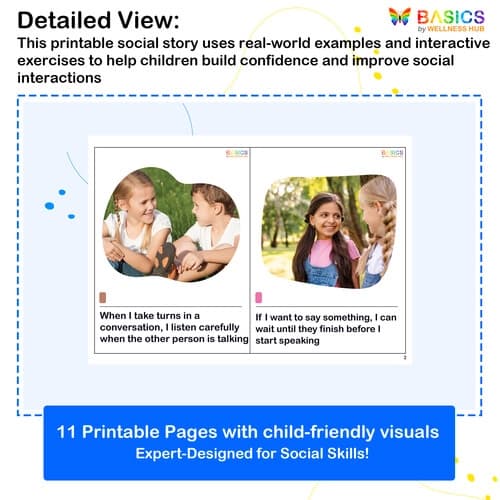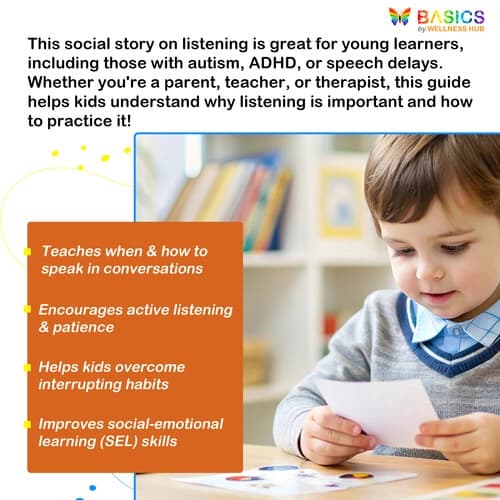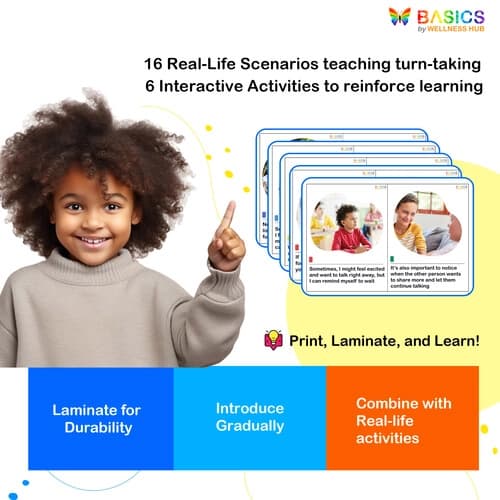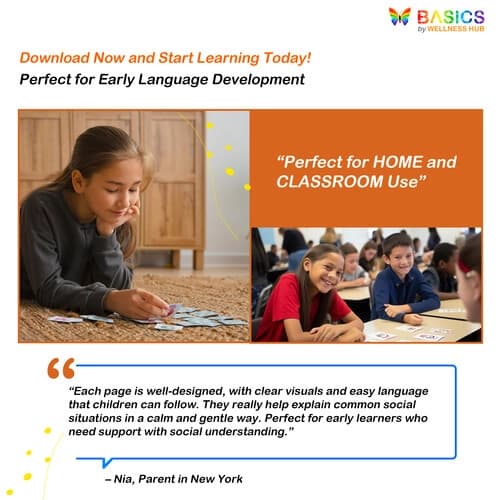



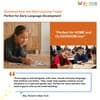
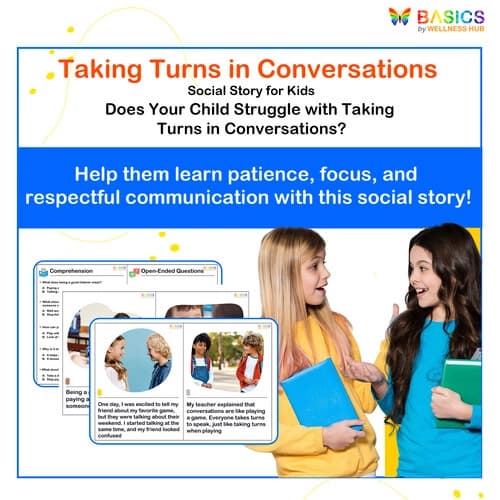
Taking Turns in Conversations – Social Story for Kids
₹80
₹160
50% off
0 (0 ratings)
Grade Levels
Pre-K - Grade 3 (Ages 4-9)
Content Overview
Format: Printable PDF, Total Pages: 11, Features (≤15 words): 16 real-life scenarios, engaging illustrations, interactive activities, easy-to-follow storytelling
Categories
Pages from the Resource
Help children learn how to take turns in conversations with this engaging social story. Through real-life scenarios, illustrations, and interactive activities, kids will practice waiting, listening, and responding appropriately in conversations. Perfect for home, classroom, and therapy use, especially for children with autism, ADHD, or social communication challenges.
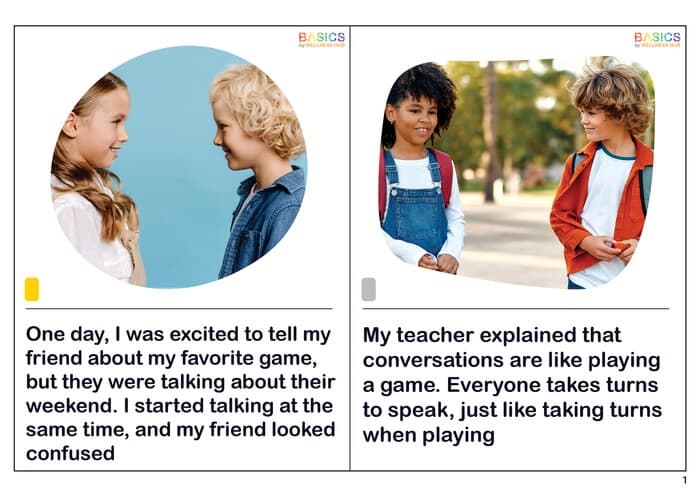
Page 1
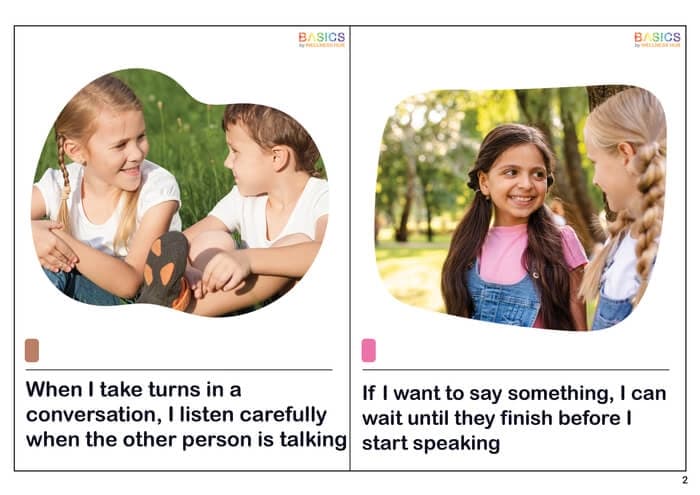
Page 2
What Users Say
0
0 ratings
5
0+
4
0+
3
0+
2
0+
1
0+
5 Stars
Product is Good to use.
1 year ago
Varsha Parent
Similar Products
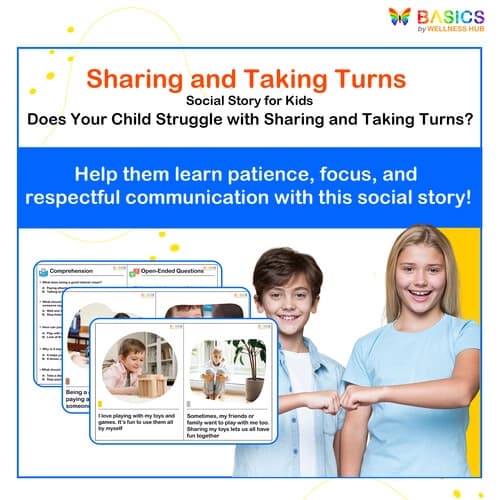
Sharing and Taking Turns – Social Story for Kids’ Social Skills
₹ 80.00
₹ 160.00
50% off
4.9 (42 ratings)
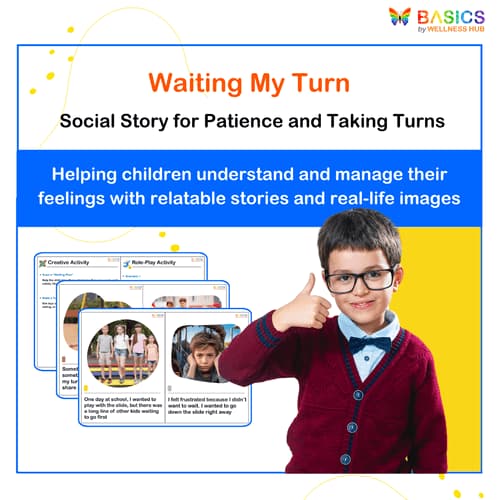
Waiting My Turn – Social Story for Patience and Taking Turns
₹ 80.00
₹ 160.00
50% off
4.7 (56 ratings)
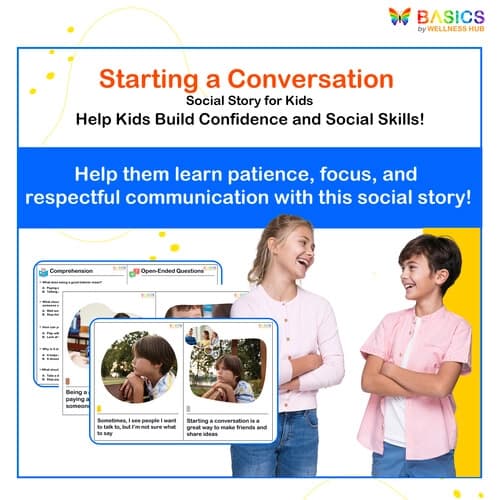
Starting Conversations – Social Story for Kids' Communication Skills
₹ 80.00
₹ 160.00
50% off
5.0 (56 ratings)
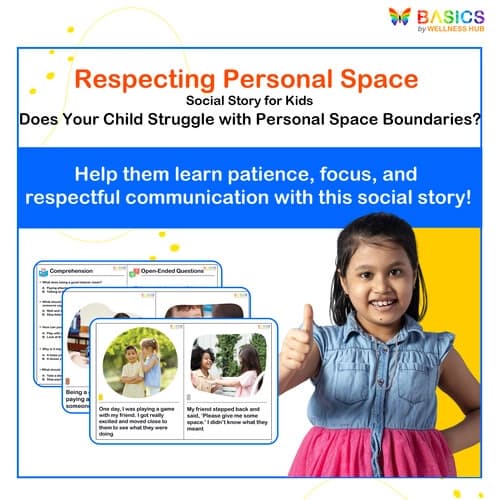
Respecting Personal Space – Social Story for Kids’ Personal Boundaries
₹ 80.00
₹ 160.00
50% off
4.9 (54 ratings)
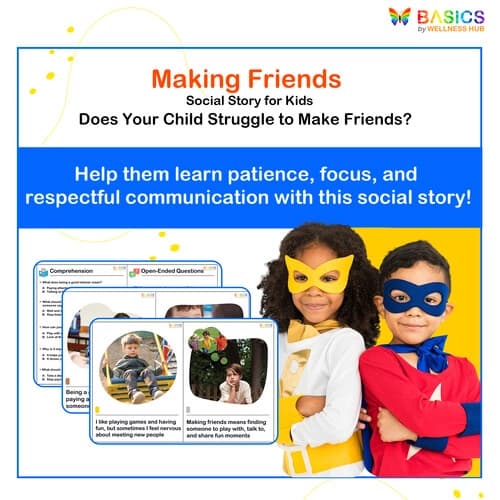
Making Friends – Social Story for Building Social Skills
₹ 80.00
₹ 160.00
50% off
4.9 (52 ratings)
About the Product
Introduction
Having a conversation is more than just talking—it involves listening, waiting, and responding appropriately. Many children, particularly those with autism, ADHD, speech delays, or social communication challenges, struggle with taking turns in conversations.
Children may:
✔ Interrupt frequently without realizing it
✔ Struggle with waiting for their turn to speak
✔ Dominate conversations or talk over others
✔ Have difficulty recognizing conversational cues
✔ Feel frustrated when others don’t let them speak
This printable social story teaches children the importance of taking turns while talking and how to actively listen and engage respectfully in conversations.
Through relatable real-life scenarios, children will learn:
✔ Why it’s important to listen before speaking
✔ How to recognize when it’s their turn to talk
✔ How to pause and wait in conversations
✔ What to do when someone else is talking
✔ How to ask questions and respond appropriately
By learning how to take turns in conversations, children will build better friendships, develop stronger social skills, and improve their communication confidence.
Product Details
- Format: Printable PDF
- Total Pages: 11
- Number of Segments: 16 real-life scenarios
- Features:
✔ Engaging illustrations demonstrating turn-taking conversations
✔ Clear, simple language for easy understanding
✔ Interactive activities to reinforce learning
✔ Designed for home, school, and therapy use
This easy-to-use social story can be printed or used digitally on tablets and computers.
Educational Benefits
1. Develops Turn-Taking & Listening Skills
- Helps children recognize when it’s their turn to speak.
- Encourages active listening and respectful conversation habits.
2. Enhances Social-Emotional Learning (SEL) Skills
- Teaches children how to wait, respond, and respect others while talking.
- Encourages self-awareness, patience, and positive communication.
3. Supports Children with Special Needs
- Provides structured, visual learning for children with autism, ADHD, or speech delays.
- Reinforces expected social behaviors in a step-by-step manner.
4. Promotes Meaningful Peer Interactions
- Encourages smooth, engaging conversations with friends, classmates, and family members.
- Helps kids navigate conversations more comfortably in everyday settings.
5. Encourages Real-Life Application
- Uses relatable scenarios (e.g., talking in class, chatting with a friend, speaking in a group).
- Reinforces social etiquette for conversations in different settings.
Instructions for Use
Step 1: Read the Social Story Together
- Sit with the child and read the story aloud, emphasizing key phrases.
- Discuss each scenario and illustration, ensuring the child understands why turn-taking matters.
- Ask guiding questions such as:
- “What should you do when someone else is talking?”
- “Why is it important to wait for your turn?”
Step 2: Engage in Interactive Learning
- Practice role-playing with the child in different conversational scenarios.
- Use the interactive activities included in the resource, such as:
✔ Fill in the blank exercises (e.g., “When my friend is talking, I should ______.”)
✔ Sorting correct and incorrect conversation responses
Step 3: Encourage Real-Life Practice
- Challenge the child to wait for their turn in at least one conversation per day.
- Use gentle reminders when they interrupt or talk over someone.
- Celebrate their progress with positive reinforcement (e.g., “Great job listening and waiting before you spoke today!”).
Step 4: Revisit & Reinforce
- Read the social story regularly to reinforce learning.
- Encourage caregivers, teachers, and peers to model appropriate turn-taking.
- Praise and encourage the child whenever they engage in conversations respectfully.
Activities Using the Resource
These engaging activities reinforce the skill of taking turns in conversations while making learning fun and interactive.
1. Conversation Turn-Taking Role-Play
Objective: Teach children how to wait, listen, and respond appropriately in a conversation.
Materials: None.
How to Play:
- Choose a conversation topic (e.g., favorite food, a recent trip, a fun memory).
- Model a conversation turn-taking example:
- Start talking and demonstrate pausing to allow the child to respond.
- If the child interrupts, gently remind them to wait until you finish speaking.
- Take turns asking and answering questions, emphasizing eye contact and patience.
- Praise the child when they wait and respond appropriately.
2. “Whose Turn Is It?” Sorting Game
Objective: Help children recognize when it’s their turn to speak.
Materials: Printable conversation cards (with different scenarios).
How to Play:
- Print and cut out conversation scenarios.
- Read a scenario aloud (e.g., “Emma is talking about her pet dog. What should Jake do?”).
- The child chooses the correct response:
- Option 1: "Wait and listen, then respond" ✅
- Option 2: "Interrupt and talk about my dog" ❌
- Discuss why waiting for a turn is important and reinforce the correct choice.
3. Conversation Ball Toss
Objective: Encourage turn-taking by passing a ball to indicate whose turn it is to talk.
Materials: A small ball or stuffed toy.
How to Play:
- Sit in a circle with 2 or more people.
- The person holding the ball speaks, while others listen quietly.
- When done talking, pass the ball to the next person, signaling it’s their turn.
- Continue until each person has had a turn to speak.
4. Conversation Jar Challenge
Objective: Encourage kids to practice turn-taking in real-life conversations.
Materials: A jar and small slips of paper.
How to Play:
- Write different conversation prompts on paper slips (e.g., "What’s your favorite game?").
- Each day, pick one prompt and have a conversation about it.
- Remind the child to wait, listen, and respond appropriately.
- Each time they take turns correctly, add a sticker or small reward.
FAQs
Q1: Who is this social story designed for?
A1: This resource is ideal for children aged 4–9 who need help learning turn-taking in conversations. It’s especially beneficial for children with autism, ADHD, speech delays, or social communication challenges.
Q2: How often should I use this social story?
A2: Use it 2–3 times per week to help children become familiar with the concept.
Pair it with interactive activities for better learning.
Reinforce turn-taking in real-life situations.
Q3: My child interrupts conversations a lot. How can this help?
A3: ✔ Use gentle reminders and model good conversation habits.
✔ Encourage pausing and thinking before speaking.
✔ Use the Conversation Jar Challenge to practice structured turn-taking.
✔ Praise and reward every successful turn-taking moment.
Q4: Can this social story help with social anxiety?
A4: Yes! It provides structured guidance and visual support, making it easier for children to understand how and when to speak in a conversation.
Q5: Can I use this in a classroom or therapy setting?
A5: Absolutely! This resource is perfect for:
✔ Classrooms – Group learning and social-emotional development.
✔ Speech therapy – Teaching waiting and conversational flow.
✔ Home learning – Reinforcing skills in a comfortable setting.
Usage Rights and Restrictions
Allowed Usage:
- Personal use by parents, teachers, and therapists.
- Printable for classroom, home, or therapy use.
- Can be used in group or one-on-one learning sessions.
Not Allowed:
- Reselling, redistributing, or modifying the resource for commercial use.
- Sharing publicly (e.g., blogs, social media, or websites) without permission.
- Uploading the file to public sharing platforms.
If you need a bulk license for schools or therapy centers, please contact us.
Conclusion
Taking turns in conversations is an essential social skill that helps children engage in respectful, meaningful interactions. This social story provides structured learning through real-life scenarios, engaging illustrations, and fun activities to make learning easy and effective.
By using this resource consistently, children will:
✔ Listen before speaking
✔ Wait for their turn in conversations
✔ Engage in positive social interactions
✔ Develop confidence in communication
With patience and practice, turn-taking will become second nature!
